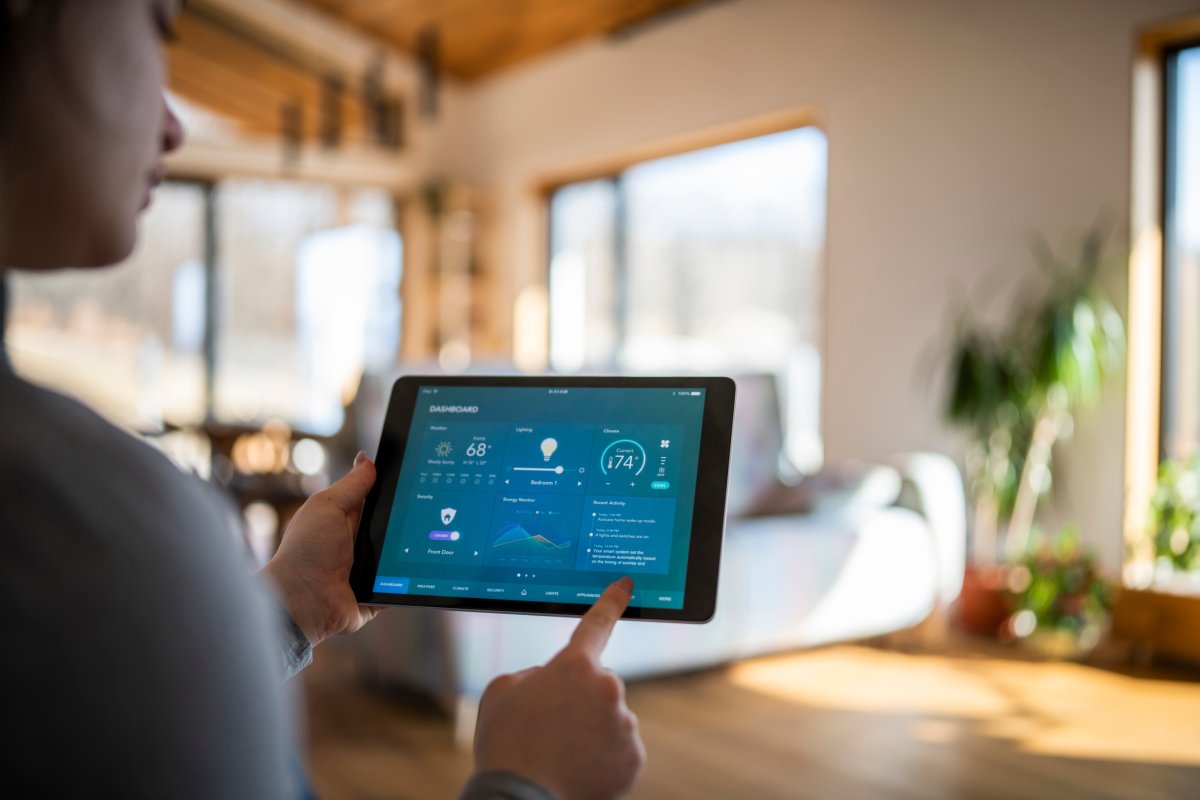

We may earn revenue from the products available on this page and participate in affiliate programs. Learn More ›
We are living in an era of rapid technological advances that are becoming more common in our everyday lives, including at home. Alexa plays the music we want to hear; Siri answers all our questions instantaneously; and AI tools like ChatGPT can write, solve math problems, organize our lives, and so much more. It’s no surprise, then, that smart furniture is the next big trend.
The global smart furniture market was valued at $3.25 billion in 2023 and is expected to reach $5.18 billion by 2030. That’s an annual growth rate of almost 7 percent from 2024 to 2030. As more people crave convenience and versatility—especially those living in small spaces—smart furniture has become an attractive solution. Discover what smart furniture is, the pros and cons of choosing it for your home, and the many options available on the market today.
What Is Smart Furniture?
As a relatively new concept, smart furniture (or intelligent furniture) refers to “modern furnishings and fixtures designed with embedded technology, sensors, and connectivity features that enhance their functionality, convenience, and usability,” says Next Move Strategy Consulting’s Smart Furniture Market report. These pieces are exciting since they can turn a sofa into a charging station, a bed into an individualized comfort zone, or a mirror into a television.
Smart furniture items are also attractive since they can connect to smart-home automation networks that users can control from a smartphone, smart-home hub, iPad, or computer. The goal with smart furniture is to tap into cutting-edge technology to create sleek multifunctional furnishings that enhance your lifestyle.

Common Features
Smart furniture typically includes one or more of the following integrated technologies:
- Built-in USB charging ports: Quickly charge electronic gadgets without using chargers or electrical outlets. Just plug your device directly into USB ports included in the furniture itself.
- Wireless charging: This feature allows you to charge USB-enabled gadgets without any wires or cords. Simply place your phone on the charging pad without having to get up from the chair or out of bed.
- Built-in sensors. This technology automatically adjusts furniture or activates features based on your specifications, such as adjustable headrests, desk height, and mattress angle.
- Fingerprint unlock: This is a type of biometric security technology that can be used in smart furniture to lock a cabinet or dresser drawer, for example.
- Built-in Bluetooth speaker: These speakers can be integrated into smart furniture to wirelessly receive digital audio.
- Touch lighting: This feature provides sheer convenience when you can simply touch a sensor in the back of your nightstand to turn on a table lamp, for example.
Benefits of Smart Furniture
“As an interior designer, I love recommending smart furniture to my clients,” says Hagan Kappler, interior designer and CEO and founder of Daisy. “Smart furniture improves their living experience through both convenience and entertainment,” she says. Here are some additional benefits you can enjoy by adding smart furniture pieces to your home:
Feel more comfortable.
The technology allows you to set up furniture to meet your needs, so you can be as comfortable as possible. “A client with limited mobility loved her automated sofa that could lift and tilt,” explains Richard Garrett of RG ProBuilders in Washington. Some sofas and beds can now be controlled by an app or voice commands via Alexa or Google Assistant, allowing easy adjustments to get the preferred mattress firmness and leg rest or headrest height.
Optimize space.
Some people choose smart furniture to save space in smaller living situations like apartments. “Many smart furniture designs are modular and customizable, making them ideal for urban dwellings where space is at a premium,” explains Brad Smith, CEO and lead designer at Omni Home Ideas in Dallas. These items are often versatile, such as providing built-in storage, lighting, and charging stations, helping to maximize use of space in a room.
Customize to your liking.
Programmable features allow you to set furniture adjustments based on personal preferences. “One underrated benefit is the flexible adaptation of technology, where the system is programmed to learn from users,” says Tony Hoang, furniture and interior expert and owner of What A Room in San Jose, California. “For instance, a chair will have some sensors through which it will detect that you tend to slouch and automatically correct it. Another is the application of artificial intelligence…such as a desk that uses AI to regulate climate control depending on the day’s schedule,” says Hoang.
Save energy.
Smart furniture can also be sustainable, helping to reduce energy use and costs through features like motion sensors and timers that automatically shut power off when not in use. In addition, smart furniture can link to a home smart hub to automate functions and optimize energy use.
Enjoy modern décor.
Adding smart furniture pieces to your home comes with the added benefit of creating a contemporary aesthetic since it’s high-tech and designed with clean lines and sleek materials.

Challenges and Drawbacks of Smart Furniture
As with any furniture purchase, there are some concerns to keep in mind. Cost could be an issue for some buyers since the integration of technology into furniture pieces typically increases the price point. Next, Smith warns that with sophistication comes complexity. “Some users may find the technology integration overwhelming,” he says.
Another concern is that the furniture may break or become obsolete since technology changes constantly. “When embedded into a product, technology is among the most complicated to maintain and may thus be costly when it requires repair or replacement,” says Hoang. For example, an intelligent sofa might include USB ports and built-in speakers, and if they need repair, it may require help from a professional service. Sometimes the entire piece of furniture will need to be replaced if it is not working as intended.
Finally, data privacy can be a concern since data used to personalize furniture could potentially be leaked in a security breach. So, when shopping for smart furniture, do your research. Choose trusted brands; read reviews; get recommendations from friends and décor experts; and ask the vendor lots of questions about warranties, repair protocol, and technology updates.
Types of Smart Furniture for Your Home
The following are some recommendations for the types of smart furniture you can purchase. Keep an eye out for new options as the technology continues to develop.
- Smart sofas. “My top recommendation to clients is always smart sofas with built-in speakers and charging ports,” says Smith. “They serve as the perfect blend of functionality and comfort, ideal for both entertaining and relaxation.” Some also allow you to customize firmness, degree of decline, and even temperature.
- Smart desks. “My personal favorite type of smart furniture is probably a height-adjustable standing desk,” says Malak Bellajdel, interior designer and consultant for Interior Moderna. “The fact that it lets you easily go between sitting and standing throughout the day has proven benefits for productivity and health. And it has smart features like height presets and activity tracking which are genuinely useful,” Bellajdel says. Pair it with a smart ergonomic chair that automatically adjusts to support your size, physique, and body weight when sitting for an ideal home office setup.
- Smart tables. “A favorite is smart tables that can charge devices wirelessly,” says Kappler. “No more dealing with tangled cords or searching for outlets. Simply place your phone on the table, and it begins charging.” Choose from a variety of smart end tables, coffee tables, and bedside tables that also have features like built-in Bluetooth speakers, smart lighting, and refrigeration compartments.
- Smart beds. Smart beds with sleep tracking for each user are also attractive. “These beds are able to change their firmness level as well as provide analysis of sleep, which enhances sleep quality by a great deal,” notes Hoang
